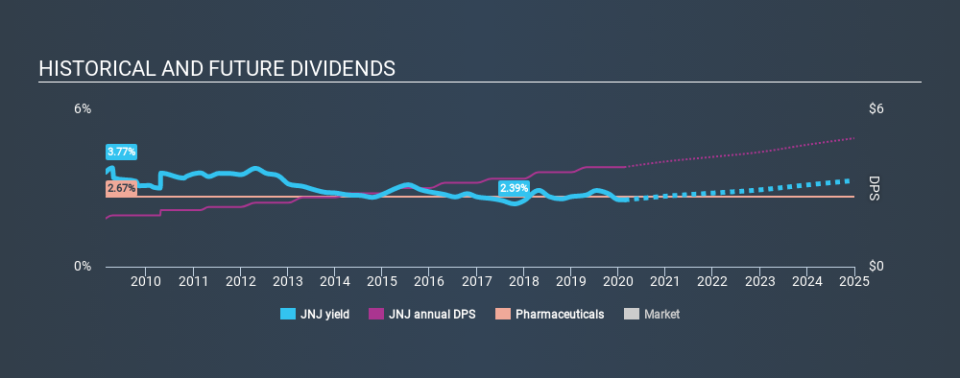We Wouldn't Be Too Quick To Buy Johnson & Johnson (NYSE:JNJ) Before It Goes Ex-Dividend

It looks like Johnson & Johnson (NYSE:JNJ) is about to go ex-dividend in the next 4 days. If you purchase the stock on or after the 24th of February, you won't be eligible to receive this dividend, when it is paid on the 10th of March.
Johnson & Johnson's next dividend payment will be US$0.95 per share, on the back of last year when the company paid a total of US$3.80 to shareholders. Looking at the last 12 months of distributions, Johnson & Johnson has a trailing yield of approximately 2.5% on its current stock price of $149.14. If you buy this business for its dividend, you should have an idea of whether Johnson & Johnson's dividend is reliable and sustainable. That's why we should always check whether the dividend payments appear sustainable, and if the company is growing.
See our latest analysis for Johnson & Johnson
Dividends are typically paid from company earnings. If a company pays more in dividends than it earned in profit, then the dividend could be unsustainable. Johnson & Johnson paid out more than half (67%) of its earnings last year, which is a regular payout ratio for most companies.
Click here to see the company's payout ratio, plus analyst estimates of its future dividends.
Have Earnings And Dividends Been Growing?
Companies that aren't growing their earnings can still be valuable, but it is even more important to assess the sustainability of the dividend if it looks like the company will struggle to grow. If earnings fall far enough, the company could be forced to cut its dividend. It's not encouraging to see that Johnson & Johnson's earnings are effectively flat over the past five years. Better than seeing them fall off a cliff, for sure, but the best dividend stocks grow their earnings meaningfully over the long run.
Another key way to measure a company's dividend prospects is by measuring its historical rate of dividend growth. In the last ten years, Johnson & Johnson has lifted its dividend by approximately 7.5% a year on average.
Final Takeaway
Has Johnson & Johnson got what it takes to maintain its dividend payments? Earnings per share have not grown at all, and the company pays out a bit over half its profits to shareholders. It might be worth researching if the company is reinvesting in growth projects that could grow earnings and dividends in the future, but for now we're on the fence about its dividend prospects.
Ever wonder what the future holds for Johnson & Johnson? See what the 17 analysts we track are forecasting, with this visualisation of its historical and future estimated earnings and cash flow
A common investment mistake is buying the first interesting stock you see. Here you can find a list of promising dividend stocks with a greater than 2% yield and an upcoming dividend.
If you spot an error that warrants correction, please contact the editor at editorial-team@simplywallst.com. This article by Simply Wall St is general in nature. It does not constitute a recommendation to buy or sell any stock, and does not take account of your objectives, or your financial situation. Simply Wall St has no position in the stocks mentioned.
We aim to bring you long-term focused research analysis driven by fundamental data. Note that our analysis may not factor in the latest price-sensitive company announcements or qualitative material. Thank you for reading.

 Yahoo Finance
Yahoo Finance 
